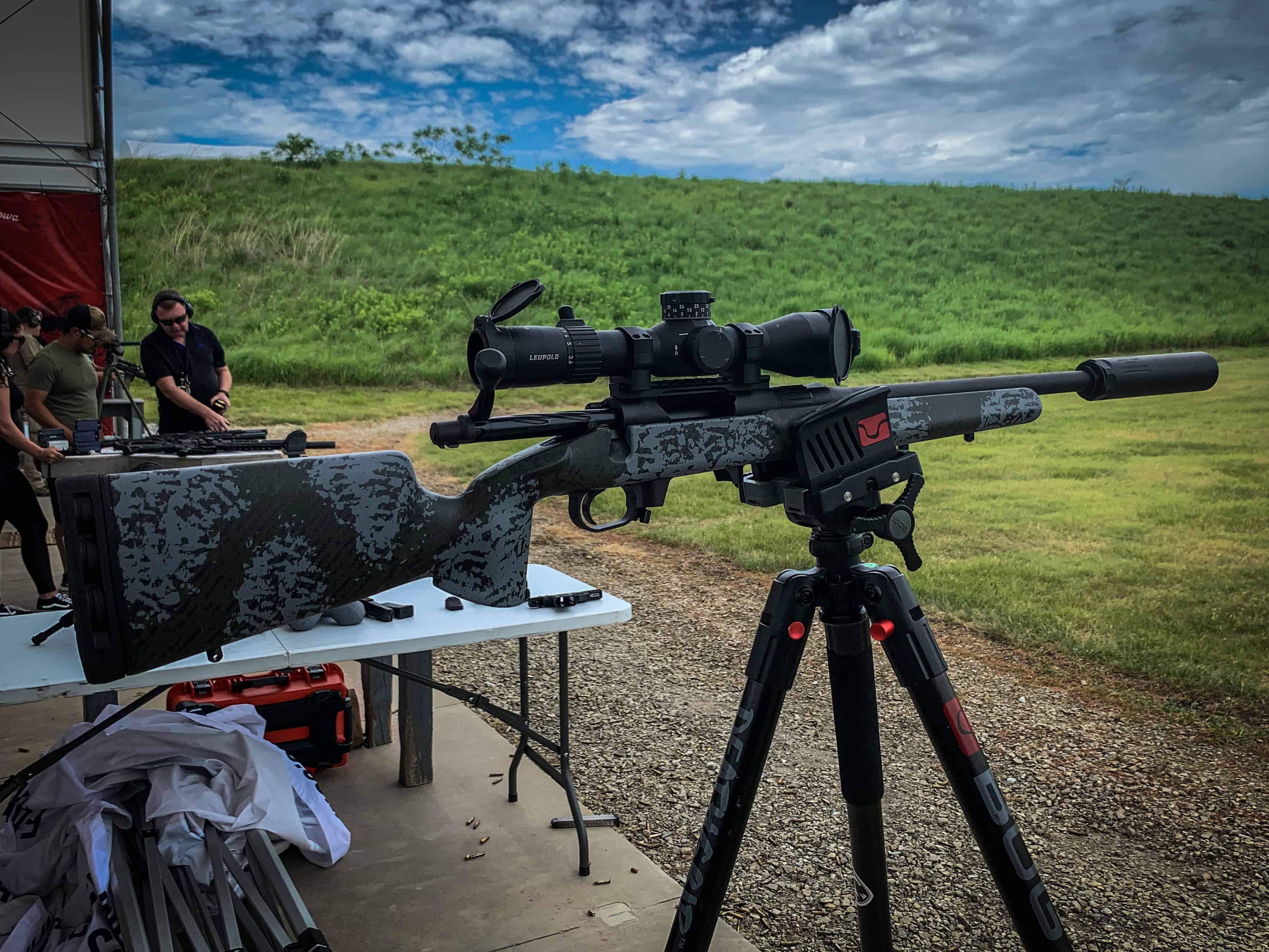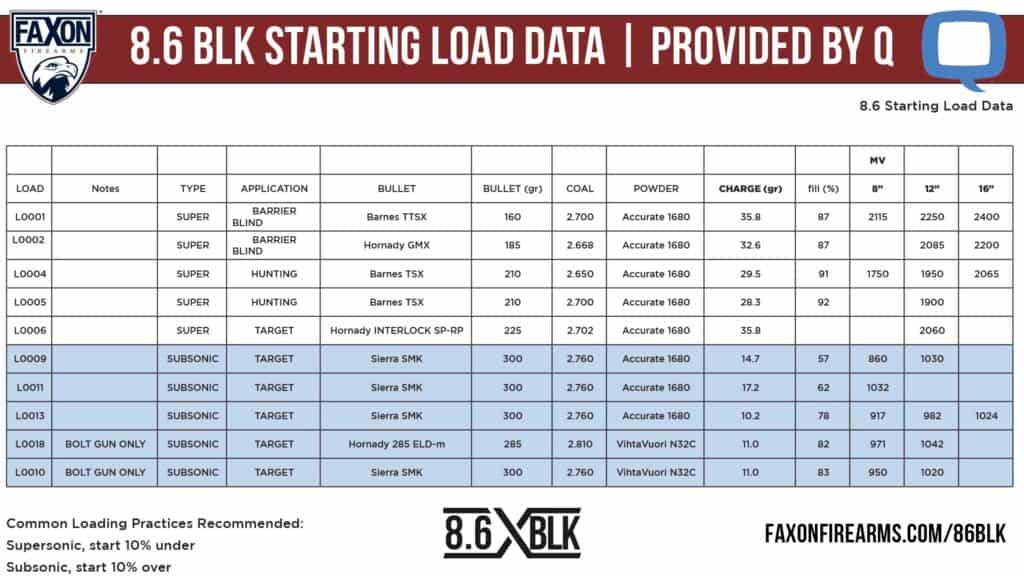
The 8.6 Blackout is taking the firearms world by storm. It is a subsonic monster that many say is capable of taking almost any game on the planet. However, just as many people are calling it a bluff. How good is it, actually? What do the 8.6 Blackout ballistics really look like?
The 8.6 Blackout outperforms the 300 Blackout in every measurable category. When fired subsonic, it uses a heavier bullet at the same velocity and achieves the same trajectory.
I love this cartridge, and although there are a few cartridges that outperform it. I really think that it has the potential to take off in today’s market.
Affiliate Disclosure: This article may contain affiliate links. When you use these links, I earn a small commission from each sale generated at no cost to you. This commission helps me continue to put out free content. I work a full-time job that I am very happy with; therefore, I don’t need this commission and am not obligated to speak highly of any product. Everything written is my own opinion: the good, the bad, and the ugly.

Short History of the 8.6 Blackout
The 8.6 Blackout goes by many names; 8.6 BLK, 8.6×43, and even 8.6 Creedmoor. It was created by Kevin Brittingham’s crew at Q, Discreet Ballistics, and Hornady. It was optimized to be used subsonic in semi-auto short-barreled rifles and pistols. The dimensions of the cartridge lend it to feed flawlessly in anything designed for the .308 Winchester or 7.62 NATO, particularly the AR-10.
Use coupon code KTG10 to get 10% off your order of $150 or more at Brownells.
The 8.6 Blackout’s parent case is the 6.5 Creedmoor, meaning that brass is widely available if you are ok with converting it. The 8.6 Blackout also has a 1:3″ twist rate, which is extremely fast compared to most centerfire rifle calibers on the market. Faxon Firearms currently makes barrels for the caliber in this twist rate, but you are lucky if you can find them in stock.
Many have tried to compare the 8.6 Blackout to the .338 Federal cartridge, which is essentially a .308 necked up to .338-inch diameter. While they may look alike and have similar cartridge overall lengths, they are very different ballistically. The 8.6 Blackout’s brass casing is much shorter as it was created to handle the heaviest 338-caliber bullets on the market while working within the overall length constraints of the AR-10. When the 338 Federal is loaded with bullets pushing 300 grains, the cartridge’s overall length becomes an issue with short action magazines. Aside from magazine length, the twist rate of most 338 Federal barrels simply can’t stabilize a bullet that heavy. The link below is a full breakdown of the two calibers and why they aren’t really the same.
Is the 8.6 Blackout a 338 Federal with Better Marketing?
The 8.6 Blackout ballistics are impressive if you keep them within their limitations. Comparing the 8.6 with other calibers is difficult because of the vastly different ballistics between its subsonic and supersonic performance. Therefore, I will treat them as two separate things and compare them to other relatable calibers using the below data as a guide.

8.6 Blackout Ballistics – Supersonic
Supersonic speed comparison could vary widely depending on what bullet weight and powder charge you use for each of the calibers. When loaded to supersonic velocities, the 8.6 Blackout is loaded with lighter-weight 338 caliber bullets. These bullet weights range from 160 to 225-grains and reach up to 2,400 fps out of a 16-inch barrel.
The bullet weight and velocity variations vary widely, so I used the loadings listed below for this calculation. As they are most likely to be considered for hunting deer-sized game.

Trajectory
The trajectory of the 8.6 Blackout is about what you’d expect of a heavy bullet moving at modest to slow velocities, very rainbow-like. However, this cartridge wasn’t really designed to shoot out to 500 yards. The 8.6’s trajectory isn’t as flat as the 338 Federal, mostly due to the lower velocities of the Blackout. However, because of the higher B.C. bullets and higher velocities, the 8.6 Blackout shoots much more flat than its little brother, the 300 Blackout.

Energy
The energy of the 8.6 Blackout is just shy of double that of the 300 Blackout. Compared to the 338 Federal, it really doesn’t come close to the energy levels at any distance. Once again, aside from being somewhat similar dimensionally, the 8.6 Blackout was not made to compete with the 338 Federal. It was developed to do something entirely different.

Supersonic comparisons are difficult to do as the 8.6 Blackout really wasn’t designed for that performance and is really in its own class. It’s a heavy bullet moving at modest velocities.
8.6 Blackout Ballistics – Battle of the Subsonics
The 8.6 Blackout really shines in the subsonic world. While the 300 Blackout, 8.6 Blackout, and 375 Raptor are all pretty different cartridges, they are all in the same subsonic family. The 300 Blackout was designed around the AR-15 platform and the 8.6 and 375 Raptor around the AR-10. These three subsonic cartridges have bullet diameters of .308, .338, and .375.
For conversation’s sake, let’s compare the three side by side. All three of these cartridges will be compared at the same subsonic velocities. 400 yards may be a stretch for the 300 Blackout, but I decided to compare all three to that distance anyway. Trajectory, energy, and velocity will be considered.
300 Blackout vs 8.6 Blackout vs 375 Raptor

The first is trajectory. The low velocities and the heavy, high ballistic coefficient bullets make these three almost identical in their trajectories. Their trajectories are so close that they are almost indistinguishable. The 8.6 Blackout and 375 Raptor are less than an inch apart at 400 yards.
Out to 400 yards, all three bullets equally held their velocity. At 400 yards, there was a difference of less than 10 fps between the three. A difference that could be easily made up for in the slight variation of each powder charge.

As expected, energy is the only metric that showed much of a difference between the three. Energy is a product of velocity and bullet weight. With velocity being equal across the board, the heavier bullet should be expected to hold more energy at every distance. This is the only metric that one has the advantage over another. The 350-grain bullet of the 375 Raptor has more energy than the 8.6 and 300 Blackout.
Marketing Makes a Difference
The 300 Blackout and 8.6 Blackout both share something that sets them apart from the 375. Marketing. What does marketing do? It creates popularity that then builds a market around it. That growing market leads to options! The 300 Blackout has been popular for a while and has plenty of bullet options. The 8.6 is slowly getting more and more. For example, the 300-grain bullet shown below was designed specifically to optimize the 8.6 with subsonic velocities.
I know what you are thinking. There are plenty of bullet options for all of them. These aren’t new bullet diameters, right? Kinda. At the introduction of these cartridges, most bullet designs in these diameters were designed to perform at much higher velocities. A whole new market has evolved, developing low-velocity, high-performance bullets.
Personally, I like the 8.6 Blackout a lot. I like the 375 Raptor even more, though. But there isn’t a market to support it right now. The 375 Raptor website is full of dead links of companies that used to make uppers and everything else for it. At the moment, the 8.6 seems like a safer bet for longevity’s sake.
How Much Recoil Does an 8.6 Blackout Have?
With a large .338 bullet diameter, the question of “how bad is the recoil?” often comes up. Having shot the 8.6, both subsonic and supersonic, I was surprised at how mild it was. For nothing more than to satisfy my own curiosity, I calculated the recoil and compared it to some well-known hunting rifles.

It has half as much recoil as the 308 Winchester and virtually no recoil when shot suppressed with subsonic loads. It’s plain fun to shoot; a smaller framed woman or young kid would have no trouble.
If interested in how recoil is calculated, read my article on recoil here!
I used the Faxon Overwatch Hunter for both 8.6 Blackout calculations, which is the rifle I have experience with. I added a little over a pound on both for optics and an additional pound for a suppressor with the subsonic load. Remember that the calculations above are for a bolt-action rifle, not an AR-10. However, the numbers are relatable, and assumptions can be made.
The 8.6 Blackout – The Future of Subsonics?
The 300 Blackout took the firearms world by storm and became extremely popular with shooters. I believe the 8.6 Blackout will be next in line. As the suppressor application process becomes more streamlined and easier, ultra-quiet subsonic firearms will see a surge in popularity. The 8.6 Blackout will ride that wave.
If interested in seeing more information on the 8.6 Blackout, check out AP2020 Outdoors on Youtube. He’s at the forefront of showing what this cartridge is capable of.

Written by: Kurt Martonik
Kurt is a Gunsmith, Reloader, Hunter, and Outdoorsman. He grew up in Elk County, Pennsylvania, where he became obsessed with the world of firearms. Following high school, Kurt enlisted in the United States Air Force as a Boom Operator, where he eventually rose to the position of Instructor. After his military service, he attended the Colorado School of Trades(CST) in Lakewood, CO for gunsmithing. Following graduation, he accepted a job at C. Sharps Arms in Montana, where he worked as a full time stockmaker and gunsmith.